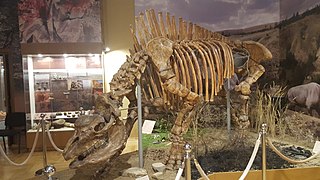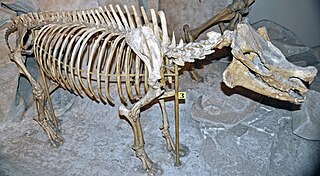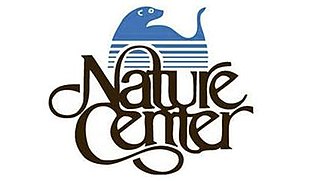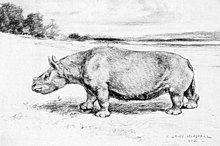
Perissodactyla is an order of ungulates. The order includes about 17 living species divided into three families: Equidae, Rhinocerotidae (rhinoceroses), and Tapiridae (tapirs). They typically have reduced the weight-bearing toes to three or one of the five original toes, though tapirs retain four toes on their front feet. The nonweight-bearing toes are either present, absent, vestigial, or positioned posteriorly. By contrast, artiodactyls bear most of their weight equally on four or two of the five toes: their third and fourth toes. Another difference between the two is that odd-toed ungulates digest plant cellulose in their intestines, rather than in one or more stomach chambers as even-toed ungulates, with the exception of Suina, do.

Elasmotherium is an extinct genus of large rhinoceros endemic to Eurasia during Late Miocene through to the Late Pleistocene, with the youngest reliable dates around 39,000 years ago. It was the last surviving member of Elasmotheriinae, a distinctive group of rhinoceroses separate from the group that contains living rhinoceros (Rhinocerotinae).

The woolly rhinoceros is an extinct species of rhinoceros that inhabited northern Eurasia during the Pleistocene epoch. The woolly rhinoceros was a member of the Pleistocene megafauna. The woolly rhinoceros was covered with long, thick hair that allowed it to survive in the extremely cold, harsh mammoth steppe. It had a massive hump reaching from its shoulder and fed mainly on herbaceous plants that grew in the steppe. Mummified carcasses preserved in permafrost and many bone remains of woolly rhinoceroses have been found. Images of woolly rhinoceroses are found among cave paintings in Europe and Asia. The species range contracted towards Siberia beginning around 17,000 years ago, with the youngest known records being around 14,000 years old in northeast Siberia, coinciding with the Bølling–Allerød warming, which likely disrupted its habitat.

A rhinoceros, commonly abbreviated to rhino, is a member of any of the five extant species of odd-toed ungulates in the family Rhinocerotidae; it can also refer to a member of any of the extinct species of the superfamily Rhinocerotoidea. Two of the extant species are native to Africa, and three to South and Southeast Asia.

Diceros is a genus of rhinoceros containing the extant black rhinoceros (Diceros bicornis) and several extinct species.

The white rhinoceros, white rhino or square-lipped rhinoceros is the largest extant species of rhinoceros. It has a wide mouth used for grazing and is the most social of all rhino species. The white rhinoceros consists of two subspecies: the southern white rhinoceros, with an estimated 16,803 wild-living animals, and the much rarer northern white rhinoceros. The northern subspecies has very few remaining individuals, with only two confirmed left in 2018, both in captivity. Sudan, the world's last known male Northern white rhinoceros, died in Kenya on 19 March 2018 at age 45.

Ceratotherium is a genus of the family Rhinocerotidae, consisting of a single extant species, the white rhinoceros, and its extinct relative Ceratotherium mauritanicum, of which Ceratotherium efficax is considered a synonym. Another species known as Ceratotherium praecox is now considered a member of the related genus Diceros. The placement of Ceratotherium neumayri from the Late Miocene of Europe and Western Asia within the genus has been questioned, with other authors assigning it to the separate genus Miodiceros. The species 'Ceratotherium’ advenientis is known from the Late Miocene of Italy.

Menoceras is a genus of extinct, small rhinocerotids endemic to most of southern North America and ranged as far south as Panama during the early Miocene epoch. It lived from around 30.7—19.7 Ma, existing for approximately 11 million years.

The Ashfall Fossil Beds of Antelope County in northeastern Nebraska are rare fossil sites of the type called lagerstätten that, due to extraordinary local conditions, capture an ecological "snapshot" in time of a range of well-preserved fossilized organisms. Ash from a Yellowstone hotspot eruption 10-12 million years ago created these fossilized bone beds. The ash depth was up to 1 foot.

Paraceratherium is an extinct genus of hornless rhinocerotoids belonging to the family Paraceratheriidae. It is one of the largest terrestrial mammals that has ever existed and lived from the early to late Oligocene epoch. The first fossils were discovered in what is now Pakistan, and remains have been found across Eurasia between China and the Balkans. Paraceratherium means "near the hornless beast", in reference to Aceratherium, the genus in which the type species P. bugtiense was originally placed.

Paraceratheriidae is an extinct family of long-limbed, hornless rhinocerotoids native to Asia and Eastern Europe that originated in the Eocene epoch and lived until the end of the Oligocene.

The Gray Fossil Site is an Early Pliocene assemblage of fossils dating between 4.5 and 4.9 million years old, located near the town of Gray in Washington County, Tennessee. The site was discovered during road construction on Tennessee State Route 75 by the Tennessee Department of Transportation in May 2000, after which local officials decided to preserve the site for research and education. The site became part of East Tennessee State University, and the Gray Fossil Site & Museum was opened on the site in 2007.

Aceratheriinae is an extinct subfamily of rhinoceros endemic to Asia, Africa, Europe, and North America, from the Oligocene through the Pliocene. It lived from 33.9 to 3.4 mya, existing for approximately 30.5 million years.

Ceratotherium neumayri is a fossil species of rhinoceros from the Late Miocene (Vallesian-Turolian) of the Balkans and Western Asia, with remains known from Greece, Bulgaria, Iran, and Anatolia in Turkey.

Aphelops is an extinct genus of hornless rhinocerotids endemic to North America. It lived from the Middle Miocene to the early Pliocene, during which it was a common component of North American mammalian faunas along with Teleoceras.

Stephanorhinus is an extinct genus of two-horned rhinoceros native to Eurasia and North Africa that lived during the Late Pliocene to Late Pleistocene. Species of Stephanorhinus were the predominant and often only species of rhinoceros in much of temperate Eurasia, especially Europe, for most of the Pleistocene. The last two species of Stephanorhinus – Merck's rhinoceros and the narrow-nosed rhinoceros – went extinct during the last glacial period.

The Western North Carolina Nature Center is a 42-acre (17 ha) zoological park in Western North Carolina operated by the City of Asheville's Parks and Recreation department. Until 1973, it was known as the Asheville City Zoo and was then renamed the Children's Zoo and Nature Center. It received its current name in 1974 when formed as a non-profit charity to develop the zoo which ultimately opened in 1976. The Center has been accredited by the Association of Zoos and Aquariums since 1999 and its collection features animals native to the southern Appalachian Mountains. In 2013 the center welcomed over 107,000 guests with over 13,000 coming from school children on field trips to the facility.

Stephanorhinus kirchbergensis, also known as Merck's rhinoceros or the forest rhinoceros, is an extinct species of rhinoceros belonging to the genus Stephanorhinus from the Middle to Late Pleistocene of Eurasia. Its range spanned from western Europe to eastern Asia. Among the last members of the genus, it co-existed alongside Stephanorhinus hemitoechus in the western part of its range.
Diceros praecox is an extinct species of rhinoceros that lived in Africa during the Pliocene, around 4 million years ago. It has been suggested to be the direct ancestor of the living black rhinoceros (Diceros bicornis).

Dihoplus is an extinct genus of rhinoceros that lived in Eurasia from the Late Miocene to Pliocene.




















